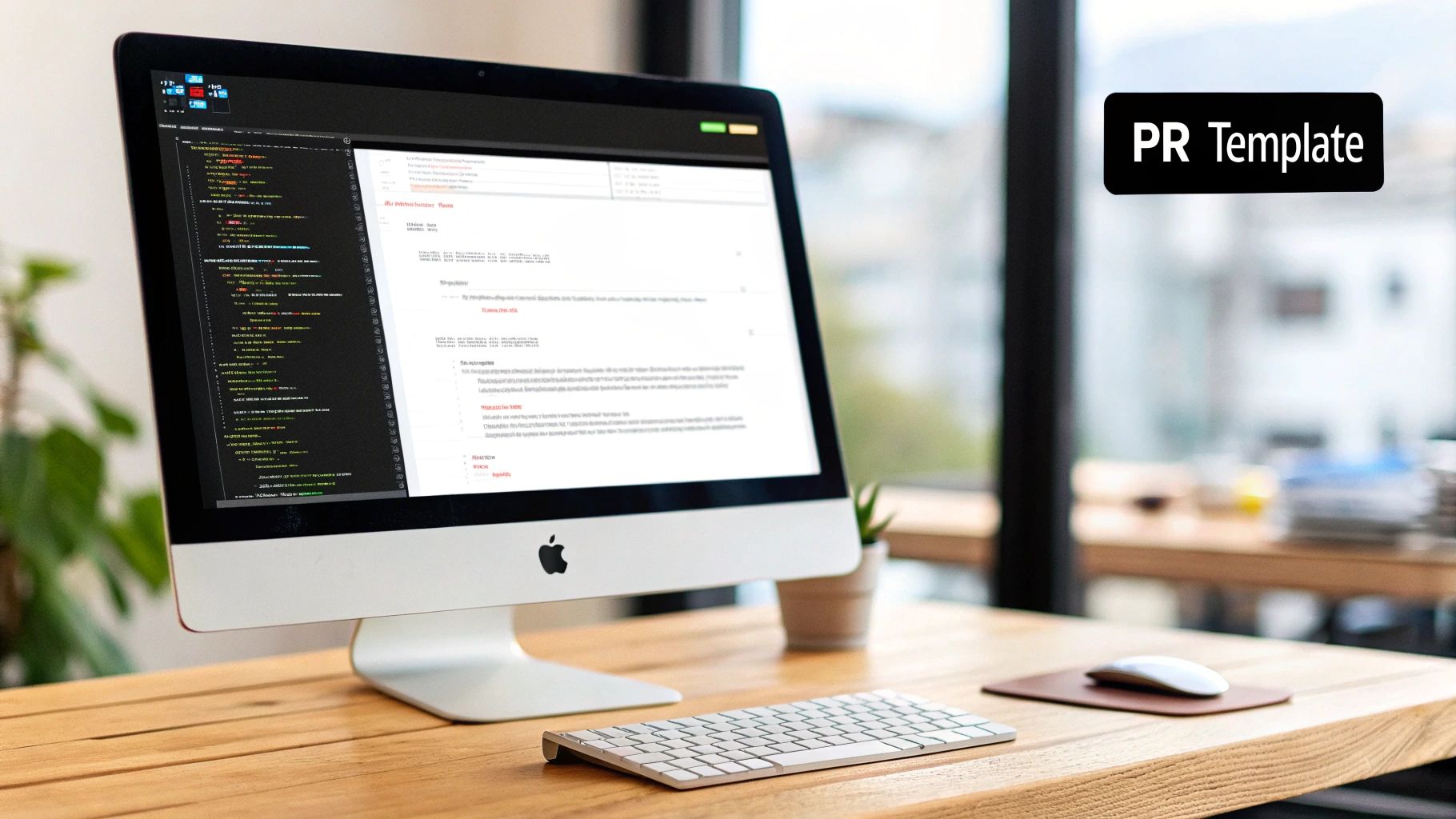Pull Request Template GitHub: Streamline Reviews
The Power of Pull Request Templates in Modern Development

Ever created a pull request (PR) and felt lost about what to include? Many developers share this experience. It highlights the rising importance of pull request templates on GitHub. These templates have gone from a nice-to-have to a must-have for effective coding collaboration. They offer a structured format, guaranteeing consistency across contributions and smoothing out the review process.
This consistency is especially helpful for expanding teams. Picture onboarding a new developer. A well-crafted pull request template on GitHub immediately clarifies project expectations. It removes the guesswork and helps new team members feel like they belong right from the start. This standardization promotes clearer communication and minimizes confusion, cutting down on the back-and-forth typical of code reviews.
Moreover, pull request templates directly tackle common development workflow headaches. Lack of context, a major cause of approval delays, can be resolved with dedicated sections for descriptions, linked issues, and testing steps. This clarity also prevents mismatched expectations that lead to needless revisions. By establishing clear guidelines upfront, templates empower both contributors and reviewers to concentrate on the code itself instead of logistical hurdles.
Pull requests are essential to modern collaborative software development. The use of pull requests on GitHub has grown considerably, emphasizing the trend towards collaborative coding. Resources like Rippling’s 'Pull Request Trends Report' enable teams to track pull request volume, spot patterns, and fine-tune workflows. This data-driven strategy helps enhance team productivity and uphold high code quality. Learn more about pull request trends. Also, explore our comprehensive guide on GitHub pull request templates. Mastering pull request templates is now more critical than ever.
Benefits of Using Pull Request Templates
Using pull request templates offers several key advantages:
- Improved Code Quality: Well-defined guidelines encourage solid coding practices and thorough testing, resulting in higher-quality code.
- Faster Reviews: Templates provide reviewers with all the necessary information upfront, speeding up reviews and shortening approval times.
- Reduced Friction: Clear expectations minimize confusion and unnecessary communication, promoting smoother teamwork between contributors and reviewers.
- Increased Consistency: Standardized templates guarantee that every pull request includes the same vital information, no matter who created it.
- Simplified Onboarding: New team members can quickly understand project expectations and contribute effectively using a template as a guide.
You may also find this helpful: How to master GitHub pull requests. Through these benefits, pull request templates turn the review process from a potential roadblock into a streamlined, efficient system that improves teamwork.
Creating Your First Pull Request Template: Step-by-Step Guide

Ready to implement pull request templates in your GitHub repository but not sure where to start? This guide will walk you through creating and implementing effective templates that your team will actually use. We'll explore several methods, from the simple .github/pull_request_template.md approach to more advanced setups using multiple templates for different kinds of contributions. This allows your team to tailor the GitHub pull request experience to their specific needs.
Setting Up Your Template File
The first step is creating the template file. This file, named PULL_REQUEST_TEMPLATE.md, uses Markdown formatting and resides in either the root directory of your repository or within a .github folder. This simple location makes the template easy to find for anyone creating a pull request.
For basic projects, a single PULL_REQUEST_TEMPLATE.md file is often sufficient. However, as your project expands and includes different contribution types (bug fixes, new features, or documentation updates), you might consider using multiple templates. This helps avoid overwhelming contributors with unnecessary details.
If you choose multiple templates, place them in a .github/PULL_REQUEST_TEMPLATE directory. When a contributor creates a pull request, GitHub will then prompt them to choose the right template. This streamlines the contribution process and provides the appropriate context for each contribution.
Designing Effective Template Content
A good pull request template provides helpful guidance without being too long. Excessively complex templates can discourage contributors, leading to incomplete or ignored information.
Here are some key elements to include:
-
Clear Description: Start with a section for a brief description of the proposed changes.
-
Related Issue(s): Include a field for linking related issues or tasks. This connects the pull request to the overall project.
-
Testing Instructions: Provide a dedicated section explaining how reviewers can test the changes.
-
Checklists: Interactive checklists help contributors ensure they've completed all the required steps. For example, running tests and updating documentation.
-
Screenshots/Visuals (If Applicable): If visuals would help, include a section for screenshots or other visual aids.
Leveraging Markdown for Enhanced Templates
Markdown lets you build dynamic and user-friendly templates. Consider incorporating these elements:
-
Checkboxes:
- [ ] Task 1creates a clickable checkbox right in the pull request. -
Dropdowns: While not a standard Markdown feature, some GitHub Flavored Markdown extensions support dropdown menus for more structured input.
-
Collapsible Sections: Use
<details>and<summary>tags to hide non-essential details until they’re needed, keeping the interface clean.
For further inspiration and examples, you can find numerous resources and ready-to-use templates online. One helpful resource is How to master GitHub PR checklists.
Implementation Methods and Best Practices
To help you choose the best approach for implementing pull request templates, here’s a comparison table:
Pull Request Template Implementation Methods Comparison of different ways to add templates to your GitHub repository
| Method | Implementation Path | Best For | Limitations |
|---|---|---|---|
| Single Template | .github/PULL_REQUEST_TEMPLATE.md | Simple projects, uniform contribution types | Less flexible for diverse contributions |
| Multiple Templates | .github/PULL_REQUEST_TEMPLATE/{template_name}.md | Complex projects, diverse contribution types | Requires clear naming conventions and contributor guidance |
This table summarizes the key differences between using a single template versus multiple templates, helping you choose the right method for your project’s complexity and contribution types. Remember to regularly review and update your templates based on feedback from your team. Continuously refining your GitHub pull request template strategy ensures it remains a valuable tool. Following these steps can significantly improve team collaboration, streamline code reviews, and ultimately enhance the quality of your code.
Essential Components That Make Templates Actually Useful

Creating a pull request (PR) template on GitHub is a great first step. But a truly effective template actively streamlines your workflow. This means including elements that empower both the contributor and the reviewer.
A clear change description is paramount. It should explain not only what was changed, but also why. This context is invaluable for reviewers. It sets the stage for a more focused and productive review.
Key Sections for Effective Templates
Beyond a detailed change description, templates should also include testing procedures. This helps reviewers verify changes. A well-structured testing section should include steps to reproduce the changes, expected outcomes, and any relevant test data. This clarity minimizes back-and-forth and speeds up the review process.
Visual aids, like screenshots or GIFs, can be extremely helpful, especially for user interface updates. These visuals quickly convey the impact of code changes, saving reviewers valuable time.
Checklists can further streamline the review process. These might cover code style, documentation, and test coverage. By prompting contributors to verify these points beforehand, templates proactively address common review feedback. This leads to fewer revisions and faster approvals. The key is balance: overly complex templates can be counterproductive.
The use of pull request templates on GitHub is gaining traction as teams strive to improve their code review workflows. These templates ensure consistency and the inclusion of vital information. Tools like the 'pull-request-analytics-action' on GitHub Marketplace offer insights into pull request metrics. This data-driven approach helps teams identify areas for improvement. You can learn more about pull request analytics.
Required vs. Optional Sections: Finding the Right Balance
Strategically using required and optional sections is vital for template effectiveness. Mandating key information, like change descriptions and testing procedures, gives reviewers essential context. But not every pull request needs the same level of detail.
Optional sections, such as those for screenshots or performance metrics, provide flexibility. This adaptable approach ensures templates remain relevant for various contributions. It promotes thoroughness and efficiency without unnecessary overhead.
The following table provides a breakdown of essential sections for a PR template:
To help illustrate these points, we've put together a handy table summarizing key sections for your pull request templates:
Essential PR Template Sections: Breakdown of key sections to include in your pull request templates
| Section | Purpose | Example Content | Impact on Review Process | |---|---|---|---| | Change Description | Explain the "why" behind the change | "This change updates the button styling to align with the new design system. This improves visual consistency across the platform and addresses user feedback about the previous design." | Provides crucial context for reviewers, enabling them to understand the motivation and intended impact of the changes. | | Testing Procedures | Outline steps to verify changes | 1. Navigate to the login page. 2. Enter valid credentials. 3. Verify successful login. | Equips reviewers with the necessary information to effectively test and validate the changes. Reduces ambiguity and potential for miscommunication. | | Screenshots/GIFs | Visually demonstrate changes | | Aids reviewers in quickly grasping the visual impact of code changes, especially useful for UI updates. Saves time and improves understanding. | | Checklist | Ensure key aspects are addressed | - Code style verified - Documentation updated - Test coverage complete | Prompts contributors to perform essential checks before submission, reducing the likelihood of common review feedback and speeding up the approval process. |
This table highlights how each section contributes to a smoother, more efficient review process. By providing context, facilitating testing, and ensuring thoroughness, these sections pave the way for higher-quality code.
This thoughtful balance between comprehensive detail and adaptable flexibility ensures templates are consistently helpful, not a burden for contributors. It promotes a more efficient and effective review process, ultimately contributing to a higher-quality codebase.
Tailoring Templates for Different Team Needs and Projects

A generic pull request template on GitHub might work for some teams, but it's rarely a perfect fit for everyone. High-performing development teams recognize that customization is essential. They tailor their pull request templates to align with specific project requirements and the various types of contributions they receive. This ensures the template serves as a helpful guide, not a rigid, inflexible form.
Specialized Templates for Various Contributions
Different contribution types often demand different information. A bug fix, for example, requires details on how to reproduce the issue. A new feature, on the other hand, needs a clear explanation of its functionality. Using separate, specialized templates prevents contributors from being bogged down with irrelevant fields, keeping the process focused and efficient.
Imagine a simple documentation update requiring the same lengthy template as a major code refactor. This can lead to frustration and incomplete sections.
For instance, a template for dependency changes might prioritize version numbers, compatibility checks, and the potential impact on other system components. A documentation-focused template, however, would emphasize clarity, consistency, and adherence to style guides. This targeted approach streamlines reviews and enhances communication, allowing reviewers to quickly locate the crucial information they need for faster turnarounds.
Implementing Multiple Templates Without Confusion
Managing multiple pull request templates on GitHub is straightforward. GitHub allows you to store various templates within a specific directory (.github/PULL_REQUEST_TEMPLATE/). Contributors can then select the most appropriate template when creating a new pull request.
This flexibility empowers contributors to provide the right information for every contribution. Using clear file names, like bug_fix_template.md or feature_request_template.md, eliminates confusion and ensures the correct template is used every time. This small step significantly improves efficiency.
Balancing Simplicity and Comprehensiveness
While detailed templates can be beneficial, finding the right balance is crucial. An overly long or complex template can overwhelm contributors and discourage participation. Consider your team's dynamics and project complexity.
A small team working on a less complex project might prefer a simpler template focused on core information. Conversely, a larger team managing a mission-critical project might require a more comprehensive template. Regularly gathering feedback from your team helps refine your templates and ensures they remain effective tools. This continuous improvement keeps your templates relevant and valuable, preventing them from becoming an outdated obstacle.
Measuring Real Impact: Is Your Template Actually Working?
Implementing pull request templates on GitHub is just the first step. The real value lies in understanding their impact and continually refining them. This goes beyond simply having a template; it requires actively measuring its effectiveness. This involves tracking key metrics and gathering feedback to understand how your templates influence your development process.
Key Metrics to Track
To assess the effectiveness of your pull request template on GitHub, focus on metrics that directly reflect its impact. One such metric is review cycle time. This measures how long it takes for a pull request to move from creation to merge. A well-designed template can significantly reduce this time by giving reviewers all the necessary information upfront. This facilitates quicker decisions and keeps the project moving forward.
Another important metric is the number of revision requests per pull request. A good template should minimize these requests by clarifying expectations and promoting better communication. Fewer revision requests translate to less back-and-forth between contributors and reviewers, freeing up valuable development time.
Finally, consider code quality metrics. While more challenging to directly quantify, a robust pull request template can contribute to better code quality. It does this by encouraging thorough testing, clear documentation, and adherence to coding standards. This proactive approach to quality can prevent issues later in the development cycle.
Tools and Approaches for Tracking
Several tools and methods can help you track these important indicators. GitHub itself provides insights into pull request activity, allowing you to monitor trends over time. Analyzing review and merge times offers valuable data about team efficiency. Tools like flowwer-dev/pull-request-stats on GitHub calculate useful metrics such as median review time and comments per review. These statistics help teams assess their performance and identify areas for improvement in their development processes. Find more detailed statistics here.
Beyond automated tools, gathering qualitative feedback from your team is essential. Regularly solicit input from both contributors and reviewers about the template’s usability and effectiveness. This feedback can uncover hidden pain points and suggest valuable improvements. For more insights into best practices, you might find this helpful: How to master essential pull request best practices.
Creating a Continuous Improvement Cycle
Effective pull request template management is not a one-time task; it’s an ongoing process. Regularly analyze your collected data and feedback to pinpoint areas for template refinement. Are certain sections consistently left blank? Do parts require clarification? Is the template too long and overwhelming, or is it missing crucial information?
By establishing a continuous cycle of feedback, analysis, and improvement, you can ensure your pull request templates stay aligned with your team’s evolving needs. This proactive, iterative process helps your templates remain relevant and useful, maximizing their impact on your workflow and contributing to a more efficient and effective development process.
Beyond Basic Templates: Automation and Advanced Techniques
Building upon a solid pull request template foundation, teams are enhancing their GitHub workflows by integrating automation and other advanced techniques. These methods improve the review process, ensuring consistency and efficiency while scaling development practices.
Automating Checks With GitHub Actions
One powerful approach combines templates with GitHub Actions. This allows teams to automate essential checks within the pull request workflow. For instance, when a pull request is created, GitHub Actions can enforce conventional commit messages, validate required template sections, or even run automated tests. This immediate feedback loop catches issues early and focuses the review process on the code.
Imagine every pull request automatically triggering a coding style guideline check. This saves reviewers time and reinforces best practices. Similarly, automated testing through GitHub Actions provides instant feedback on code changes, reducing regression risks.
Dynamic Templates: Adapting to Context
Another advanced technique involves creating dynamic templates. These templates adapt based on factors like the branch name or changed files. This contextual awareness creates a more tailored and efficient contributor experience.
A pull request targeting a "hotfix" branch could use a streamlined template prioritizing speed and focusing on the immediate issue. A new feature pull request, however, could trigger a comprehensive template prompting for detailed documentation and testing procedures. This flexibility ensures template relevance.
Integrating Templates Into a Broader Quality Strategy
Teams are also leveraging templates as part of a larger quality strategy. By integrating automated checks for coding standards, documentation, and testing protocols directly into pull requests, teams build quality assurance into their workflow.
This proactive approach helps prevent bugs and ensures consistency, leading to a more reliable codebase. Teams can even automatically label pull requests based on template content, further streamlining workflow and organization. This automation reduces manual effort and allows reviewers to prioritize effectively.
These advanced techniques combine the structure of pull request templates with automation, enabling teams to scale their processes while maintaining high-quality standards. They empower teams to move faster, collaborate better, and build better software.
Ready to automate your code review process on GitHub? Pull Checklist, a GitHub Marketplace app, offers powerful, condition-based checklists within pull requests. From enforcing required tasks to customizable templates and detailed reporting, Pull Checklist helps maintain high-quality reviews, reduce mistakes, and enhance collaboration. Learn more at Pull Checklist.
